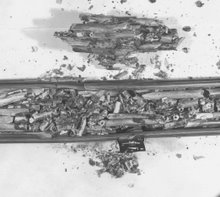An 8 inch length of BWR fuel (depleted uranium dioxide in zircaloy cladding) was induction heated in pressurized water to the point of severe overtemperature. Three exploratory (probing) tests are reported here. The first test was at relatively modest conditions and the cladding remained intact. However,even in this case, there was an extensive reaction between the zircaloy and the uranium dioxide as the heated zircaloy was pressed against the uranium dioxide at the modestly high temperature.
The second test was at severe conditions and the heated section was essentially destroyed with the rapid oxidation of the zircaloy cladding and the extensive chemical reactions between the zircaloy and the uranium dioxide.
The third test was also at very severe conditions with the results of the second test and the production of molten alloy that froze to the specimen.
The following images and text is draft material from 1964. IT HAS ALWAYS BEEN SENSITIVE DOCUMENTATION, BUT IS NOW DISCLOSED. Remember, you may click on any image for enlargement.
 Above is an exploded view of the test apparatus including the BWR fuel specimen.
Above is an exploded view of the test apparatus including the BWR fuel specimen. Above is the assembled test apparatus.
Above is the assembled test apparatus.
Above is a specimen of Zircaloy tubing under exposure to water-steam at atmospheric pressure. This is not the test apparatus of this presentation; it is presented here as an illustration of the technique and the general appearance of the heated zone.
 Above is the comparison of heated and unheated specimens. This clearly illustrates the zone of heating. This is an 8 inch length of BWR fuel with depleted uranium dioxide pellets. The metallography revealed chemical reactions between the Zircaloy-2 and the uranium dioxide although the cladding remained intact. The metallography is detailed in the following slides.
Above is the comparison of heated and unheated specimens. This clearly illustrates the zone of heating. This is an 8 inch length of BWR fuel with depleted uranium dioxide pellets. The metallography revealed chemical reactions between the Zircaloy-2 and the uranium dioxide although the cladding remained intact. The metallography is detailed in the following slides.
Although the macro slide (way above) indicates a very robust fuel rod with only discoloration from the heating in pressurized water steam, this slide shows that degradation of the assembly is underway. Note the ...
 Further details of degradation. Metallographer Rooney notes, "2. A layer which is rich in uranium."
Further details of degradation. Metallographer Rooney notes, "2. A layer which is rich in uranium."
And more details.....
 Above is the next test, and here we are getting down to business. These photos show the element while still in the test apparatus. The extensive chemical reactions (Zircaloy and uranium dioxide) have severed the specimen. The lower section has dropped to the lower plate, while the top section remains suspended by the support wire.
Above is the next test, and here we are getting down to business. These photos show the element while still in the test apparatus. The extensive chemical reactions (Zircaloy and uranium dioxide) have severed the specimen. The lower section has dropped to the lower plate, while the top section remains suspended by the support wire.

As I look back on this 1964 work today,October 1, 2008, it indeed was great exploratory research conducted in an atmosphere that was not conducive to this activity. In the second slide immediately above, a frozen melt is apparent. This frozen melt should have been sectioned for detailed study including chemical analysis; it was not.









No comments:
Post a Comment